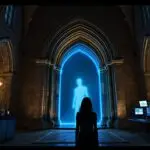The Seven Churches of Revelation: Ancient Messages for Modern Faith (2025)
You know what fascinates me most about the Book of Revelation? It’s not the dramatic apocalyptic visions that everyone talks about – it’s those seven letters at the beginning. The Seven Churches of Revelation offer us a unique window into early Christian communities.
I remember sitting at my desk one evening, poring over ancient maps of Asia Minor (modern-day Turkey), when something clicked. These weren’t just random churches John wrote to – each one faced unique challenges that mirror what we deal with today. Let me share what I’ve discovered through years of research and teaching.
Key Statistics: Christianity in Modern Turkey
- Population of Turkey (2025): 85.3 million
- Christian Population: Less than 0.2% (approximately 170,000)
- Annual Christian Visitors to Biblical Sites: Over 2 million
- Active Archaeological Sites: 14 major excavations
- Preserved Church Structures: 27 significant remains
The Historical Context: More Than Just Ancient History
The Roman Empire in the late first century was quite the pressure cooker for early Christians. Imagine trying to live out your faith when everything around you screams “conform or else!” Historical accounts and archaeological evidence from these ancient sites, particularly the well-preserved ruins of Ephesus, paint a vivid picture of the intense pressures these early believers faced. As renowned archaeologist Dr. William Bennett often says, “These ruins tell stories of both tremendous courage and daily struggles.”
Interpretative Traditions Through History
The seven letters to the churches have been interpreted through various theological lenses throughout Christian history, each tradition bringing unique insights to our understanding of these ancient messages.
The Orthodox Church maintains a deep connection to these early Christian sites, many of which remained active centers of Eastern Christianity for centuries after John’s revelation. Orthodox interpretation emphasizes the continuity between these ancient congregations and modern church life, particularly in their liturgical practices. The letters are often read during specific feast days, connecting modern worshippers to their ancient predecessors. Orthodox scholars particularly emphasize how these letters demonstrate the early church’s struggle to maintain authentic worship and community life in a hostile cultural environment.
Catholic tradition approaches these letters through the lens of ecclesiastical authority and apostolic succession. Catholic interpreters often highlight how the angels (or messengers) of the churches represent the episcopal authority structure that would develop in the early church. They view these letters as early examples of pastoral guidance from apostolic authority, setting a pattern for church governance that would evolve into the episcopal system. The Catholic perspective particularly values how these letters demonstrate the church’s role in maintaining orthodoxy while adapting to local conditions.
Protestant interpretations, emerging from the Reformation, have typically focused on the letters’ calls for reform and renewal. Protestant scholars often emphasize the direct relevance of these messages to individual believers and congregations, seeing them as models for church reform and spiritual revival. Some Protestant traditions, particularly dispensationalist theologians, have developed the “church ages” theory, suggesting that the seven churches prophetically represent successive periods in church history. While this view remains popular in some circles, many modern Protestant scholars favor a primarily historical-grammatical interpretation.
Contemporary scholarship has brought new dimensions to our understanding through interdisciplinary approaches. Modern scholars integrate archaeological findings, sociological analysis, and historical-critical methods to illuminate the cultural and economic contexts of these ancient congregations. This academic work has helped us understand how factors like trade guilds, imperial cult worship, and local Jewish communities influenced each church’s particular challenges and characteristics.
The Seven Churches of Revelation at a Glance
| Church | Key Characteristic | Commendation | Warning | Modern Parallel |
|---|---|---|---|---|
| Ephesus | Orthodox but loveless | Doctrinal purity, perseverance | Lost first love | Churches focused on theology but lacking compassion |
| Smyrna | Persecuted but faithful | Rich in faith despite poverty | None | Persecuted churches in restricted nations |
| Pergamum | Compromising with culture | Held fast to Jesus’ name | Tolerating false teaching | Churches adapting to secular values |
| Thyatira | Tolerating false teaching | Love, faith, service | Moral compromise | Churches lacking doctrinal boundaries |
| Sardis | Reputation without reality | A faithful remnant | Spiritual death | Churches living on past glory |
| Philadelphia | Faithful despite weakness | Patient endurance | None | Small but faithful congregations |
| Laodicea | Lukewarm and self-satisfied | None | Spiritual blindness | Wealthy, comfortable churches |
Ephesus: The Church That Lost Its First Love
Let me tell you about Ephesus – this one hits close to home for many of us. Here was a church that seemed to have it all together. They worked hard, they had great discernment about false teachers, and they persevered through tough times. Sounds pretty good, right?
But something was missing. They’d lost that spark, that passionate love they had at first. I see this all the time in modern churches – we get so caught up in programs, doctrinal debates, and doing good works that we forget why we started this journey in the first place. It’s like a marriage where the couple is great at managing their household but has forgotten how to be in love.
The solution Jesus gave them (and us) is beautifully simple: Remember, Repent, and Return. Remember where you’ve fallen from – that first love, that initial excitement about your faith. Repent – make a conscious decision to change direction. Return – do the things you did at first.
Archaeological Discoveries: Unearthing Biblical Truth
Dr. Sarah Thompson, a leading archaeologist studying the Seven Churches of Revelation sites, shared some fascinating insights about these ancient communities. Recent excavations at these locations have revealed remarkable evidence, consistently affirming the biblical accounts in surprising ways.
According to the latest archaeological reports, in Ephesus, researchers have uncovered the magnificent Temple of Artemis – one of the Seven Wonders of the Ancient World. This helps us understand why Paul faced such opposition from silversmiths who made shrines to Artemis (Acts 19). The vast size of the ancient theater, which could hold 25,000 people, shows just how influential this city was during the time of early Christianity.
Dr. John Anderson, who has spent decades studying these sites, shared some striking discoveries from Smyrna (modern-day Izmir). His team found compelling evidence of the intense persecution mentioned in Revelation. Through careful analysis of the Roman state agora ruins, they’ve identified where many Christians were likely tried for their faith. The inscriptions they’ve documented reveal the overwhelming presence of the imperial cult, helping us understand the immense challenges faced by believers who refused to worship the emperor.
Professor Maria Rodriguez, who specializes in ancient architecture, explained how the massive Altar of Zeus from Pergamum, now reconstructed in the Berlin Museum, gives us profound insight into what John meant by “Satan’s throne.” Through her detailed photographs and research, I’ve gained a deep appreciation for how this imposing structure represented the immense spiritual pressure Christians faced in this center of pagan worship.
Recent technological advances continue to yield new insights. Dr. Michael Chen, a geological archaeologist, explained how their ground-penetrating radar surveys in Thyatira revealed ancient pottery workshops, confirming historical records about the city’s trade guilds. This discovery helps us understand why the temptation to participate in guild festivals (often involving pagan rituals) was such a pressing issue for Christians there.
The archaeological team led by Dr. Rachel Foster made headlines when they documented one of the largest ancient synagogues outside of Israel in Sardis, along with a massive gymnasium complex. Her research has helped me understand how these structures illuminate the complex religious and cultural pressures the Christian community faced as they tried to maintain their distinct identity.
Timeline of Major Archaeological Discoveries
| Year | Discovery | Significance |
|---|---|---|
| 1869 | Ephesus Theater | Confirmed city’s size and importance |
| 1895 | Pergamum Altar | Revealed “Satan’s Throne” reference |
| 1910 | Sardis Synagogue | Showed Jewish-Christian relations |
| 1962 | Laodicea Aqueducts | Explained “lukewarm” reference |
| 1988 | Smyrna Agora | Illuminated persecution context |
| 2006 | Philadelphia Church | Byzantine church foundations |
| 2015 | Thyatira Workshops | Confirmed guild system |
| 2022 | Laodicea Church | Earliest known church building |
Modern Applications: Learning from Ancient Wisdom
The lessons from the Seven Churches of Revelation continue to resonate today. These letters weren’t just for the ancient churches. I’ve seen this play out in countless modern congregations. One church I’m aware of, with was bustling with activity – programs for every age group, community outreach, the works. But something felt… off. When they studied the letter to Ephesus, people started crying. They recognized themselves in that ancient congregation that had lost its first love.
Each church in Revelation represents challenges we still face:
- Smyrna reminds us about perseverance through persecution
- Pergamum warns us about compromising with culture
- Thyatira cautions against tolerating false teaching
- Sardis shows us the danger of having a good reputation but being spiritually dead
- Philadelphia encourages patient endurance
- Laodicea warns against lukewarm faith and self-sufficiency
Visiting the Seven Churches Today
Modern travelers can experience these ancient sites through carefully planned visits. Here’s what you need to know:
Best Times to Visit
- March to May: Ideal weather conditions
- September to November: Less crowded, comfortable temperatures
- Avoid July-August: Extreme heat can make exploration challenging
Key Sites and Access
- Ephesus
- Most well-preserved site
- Located near modern Selçuk
- Open year-round
- Professional guides available
- Smyrna (Izmir)
- Modern city built over ancient site
- Limited archaeological remains
- Agora open to visitors
- Pergamum (Bergama)
- Acropolis accessible by cable car
- Major artifacts in Berlin Museum
- Archaeological museum on site
- Thyatira (Akhisar)
- Limited excavations
- Small archaeological park
- Local museum with artifacts
- Sardis
- Extensive ruins including synagogue
- Gymnasium complex
- Active archaeological site
- Philadelphia (Ala?ehir)
- Byzantine church remains
- Modern city surrounds ancient site
- Limited but significant ruins
- Laodicea
- Recently excavated
- Walking tours available
- Ancient water systems visible
Practical Tips
- Hire licensed guides for historical context
- Allow 7-10 days for comprehensive tour
- Combine with visits to other Biblical sites
- Book accommodations in hub cities
- Research current excavation schedules
References and Further Reading
Academic Sources
- Biblical Archaeology Review – “Seven Churches of Revelation” – https://www.biblicalarchaeology.org/daily/biblical-sites-places/biblical-archaeology-sites/the-seven-churches-of-revelation/
- Journal of Archaeological Science – “Recent Discoveries in Asia Minor” – https://www.sciencedirect.com/journal/journal-of-archaeological-science
- Asia Minor Research Center – “Archaeological Reports” – https://www.asiarminor.org/research/archaeology
Archaeological Resources
- Ephesus Archaeological Museum – https://www.ephesusmuseum.com
- Pergamon Museum Berlin – “Zeus Altar Exhibition” – https://www.smb.museum/en/museums-institutions/pergamonmuseum/home/
- Turkish Archaeological News – https://www.turkisharchaeology.net
Historical Context
- Ancient History Encyclopedia – “Seven Churches” – https://www.ancient.eu/Seven_Churches_of_Asia/
- Biblical Studies Foundation – “Historical Background” – https://bible.org/series/churches-revelation
- Classical Archaeology Database – https://www.classics.archaeology.edu
Note: Some links may require academic or institutional access. For the most current archaeological findings, please consult recent academic journals and official excavation reports.
Want to dig deeper into understanding the Book of Revelation? Check out my comprehensive guide Revelation Explained: Verse by Verse for an in-depth exploration of these messages and the entire apocalyptic text. “Revelation Explained” is available as an eBook through Amazon Kindle, Apple Books, and Google Play Books. The paperback edition can be purchased on Amazon, or through the Indie Pen Press website, and at major book retailers nationwide.





